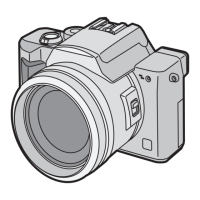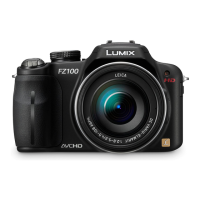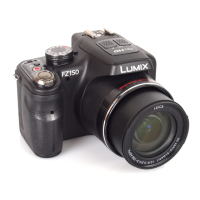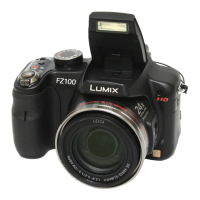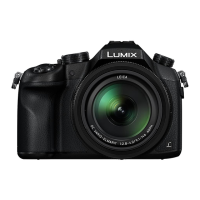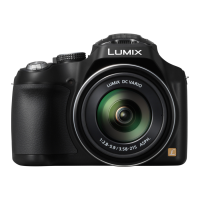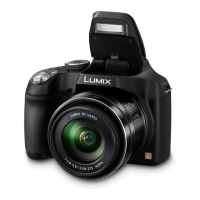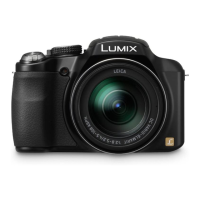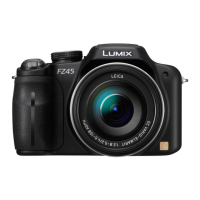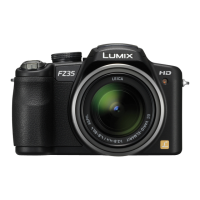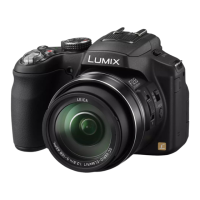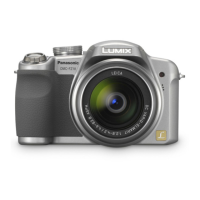
Do you have a question about the Panasonic LUMIX DMC-FZ18 and is the answer not in the manual?
| Brand | Panasonic |
|---|---|
| Model | LUMIX DMC-FZ18 |
| Category | Digital Camera |
| Language | English |
Essential safety precautions and warnings for operating the camera and handling components.
Lists all items included in the camera package for initial setup.
Identifies and labels the various parts and buttons of the camera.
Instructions on how to attach the lens cap and camera strap for protection and carrying.
Steps to attach the lens hood to improve picture quality by reducing flare.
A brief overview of essential steps for recording and playback with the camera.
Detailed instructions on how to charge the camera's battery pack correctly and safely.
Information on battery life, charging times, and estimated number of pictures per charge.
Procedures for correctly inserting and removing memory cards and the battery.
Explains the use and capacity of the camera's internal memory and optional memory cards.
Guide to setting the camera's internal clock and date for accurate record keeping.
Explains the different recording and playback modes available via the mode dial.
Overview of how to access and navigate the camera's various menu screens and options.
Details specific settings available within the camera's setup menu.
Details on how to change and interpret the information displayed on the LCD and viewfinder screens.
Fundamental steps and techniques for capturing still photographs with the camera.
How to use the camera's Intelligent Auto mode for effortless, automatic picture taking.
Instructions on using the optical, extra optical, and digital zoom functions for framing.
How to review, enlarge, and delete pictures immediately after taking them.
Procedures for browsing, selecting, and deleting recorded still pictures and motion pictures.
Explains the display elements and options for the LCD monitor and viewfinder in recording mode.
Guide to using the camera's built-in flash for various lighting conditions and effects.
How to use the self-timer function for group shots or to avoid camera shake.
Techniques to adjust exposure manually for brighter or darker images when automatic settings are insufficient.
How to capture multiple shots with varying exposures automatically for better results.
Instructions on capturing a rapid sequence of images for action shots.
Techniques for capturing detailed close-up shots of subjects, including macro and tele-macro functions.
How to control depth of field by manually setting aperture values while the camera adjusts shutter speed.
How to control motion blur by manually setting shutter speed while the camera adjusts aperture.
Full manual control over both aperture and shutter speed for precise exposure settings.
How to manually focus the lens for precise control, including using MF Assist.
How to save and recall custom camera settings for different shooting scenarios.
Using saved custom settings to quickly apply preferred configurations to the camera.
Utilizing advanced scene modes for optimal results in specific shooting situations like portraits and landscapes.
Selecting predefined scene modes to automatically optimize camera settings for common subjects.
Instructions for recording video clips with audio and adjusting picture settings.
Feature to record and display the day of a vacation when a picture is taken.
Setting and displaying local time at a travel destination in addition to home time.
Detailed guide to accessing and adjusting various recording parameters via the REC menu.
Adjusting white balance to ensure accurate color reproduction under different lighting conditions.
Fine-tuning white balance settings for precise color control and correction.
Automatic adjustment of ISO sensitivity and shutter speed based on subject movement and brightness.
Manually setting ISO sensitivity to control light capture, especially in low-light conditions.
Selecting different aspect ratios for images to match viewing devices or creative preferences.
Adjusting image resolution (pixels) and compression level for optimal quality or file size.
Enabling or disabling audio recording alongside still pictures.
Selecting the method used by the camera to measure scene brightness for exposure.
Choosing different autofocus modes, including face detection, for precise subject focus.
Activating image stabilization to reduce blur caused by camera shake.
Enabling continuous autofocus for tracking moving subjects.
Using the AF assist lamp to improve focus in low-light conditions.
Locking focus and/or exposure settings on a subject for precise composition.
Applying creative color effects such as black and white or sepia to images.
Adjusting picture parameters like contrast, sharpness, saturation, and noise reduction.
Creating short motion picture files by capturing sequential still images.
Using optional tele conversion and close-up lenses to extend camera capabilities.
Viewing multiple recorded pictures simultaneously on the LCD screen for quick browsing.
Organizing and viewing pictures based on their recording date using a calendar interface.
Magnifying recorded pictures to examine details closely during playback.
How to play back recorded motion pictures and still pictures with audio.
Extracting individual still frames from recorded motion picture clips.
Accessing and utilizing various playback functions like slide shows, protection, and editing.
Displaying pictures automatically in a sequence with adjustable duration, effects, and audio.
Sorting and searching pictures based on recording information or scene modes.
Automatically or manually rotating pictures for correct vertical orientation.
Marking pictures as favorites for easier selection and playback.
Adding text comments or titles to pictures for identification or printing.
Stamping recorded text, dates, ages, or travel dates onto pictures for printing.
Setting print order information for compatible printers, specifying pictures and quantities.
Preventing accidental deletion of important pictures by applying a protection lock.
Adding or overwriting audio commentary onto still pictures.
Reducing the picture size for email or web use, creating a new smaller image file.
Cropping pictures to focus on a specific part, creating a new image file.
Converting picture aspect ratios, such as from 16:9 to 4:3 or vice versa.
Copying picture data between the camera's built-in memory and a memory card.
Initializing the built-in memory or memory card, erasing all data.
Steps for transferring pictures and videos from the camera to a computer.
Connecting the camera directly to a PictBridge compatible printer for printing.
Connecting the camera to a television to view pictures and videos on a larger screen.
Attaching protective or light-reducing filters to the camera lens.
Explaining the various indicators and information shown on the camera's LCD and viewfinder screens.
Important warnings and guidelines for optimal and safe operation of the camera.
Explanations of common confirmation and error messages displayed on the camera screen.
Solutions for common problems encountered during camera operation, recording, and playback.
Tables showing estimated picture counts and recording times for various settings and media.
